BIOS 431 Plant Harvesting and Domestication by Humans
1/81
Earn XP
Description and Tags
Flashcards about plant domestication and harvesting
Name | Mastery | Learn | Test | Matching | Spaced |
|---|
No study sessions yet.
82 Terms
What is domestication?
an evolutionary mutualism, often rather asymmetric, between humans and another organism.
How does the domestication of plants progress?
The domestication of plants progresses through evolutionary divergences, where one or several founder populations gradually acquire variable degrees of geographical or genetic isolation from their wild relatives.
What happens after divergence in plant domestication?
After divergence, reproduction and geographical spread of domesticated plants become increasingly dependent on humans.
What are the selective forces in cultivated plants?
Selective forces under cultivation differ from those in the wild and include strong directional selection by humans and natural selection caused by cultivation conditions.
What roles do inbreeding and genetic drift have in domesticated species?
Inbreeding and genetic drift play a role in the evolution of domesticated species.
What is the significance of domestication in the context of evolutionary relationships?
Domestication is probably our single most significant evolutionary relationship with plant species, aside from competition for habitat and the mass movement of species.
Are all useful plant species domesticated?
Not every useful plant species has been domesticated; we still extract resources from wild populations, which are often intensively managed.
How long has domestication been part of human-plant relationships?
Domestication covers a wide range of mutualistic relationships dating back 10,000 years or more. This is why militaries from different societies look to conquest agricultural societies.
What is domestication described as?
described as an evolutionary process resulting from an ecological mutualism, not as a historical event.
How does the geographic origin of domestications vary?
Different domestications have different geographic points of origin and occurred at different times, indicating that the process did not happen all at once.
What role did humans play in early plant domestication?
Humans often continued to gather the wild crop while simultaneously propagating the plants in an agricultural setting. As a result, they an trade these plants
What evolutionary processes are involved in domestication?
Natural selection is not the only process; genetic drift (loss of genes), mutation, and allele flow with closely related species also play major roles.
How is the domestication of plants typically portrayed?
is often portrayed as starting with incidental means and moving to directed means; however, incidental changes continue to occur.
What is an example of incidental change in domesticated plants?
Most ornamental roses no longer offer a characteristic floral smell due to obsessive breeding for showy characteristics and random genetic drift.
What does 'incidental' mean in the context of domestication?
that the human partner in the mutualism was not applying selection on purpose; selective pressure occurs as an unintended consequence.
What does 'directed' mean in the context of domestication?
Directed means that the human partner intentionally applies artificial selective pressure to achieve a specific result.
How is genetic drift correlate with domesticaiton?
Genetic drift in domestication refers to the random changes in the gene pool of domesticated plants over time, which can lead to unintended alterations in traits and loss of variety of genes, especially when selection pressures are not consistently applied by humans.
Talk about the civilizations in the Amazon rainforest in terms of domestication
The civilizations in the Amazon rainforest practiced domestication by cultivating a diverse range of crops, such as manioc and groundnuts, which were well adapted to local environmental conditions and contributed to their sustainable agricultural practices.Gowever, colonization ruins everything by introducing diseases to the cilvizations
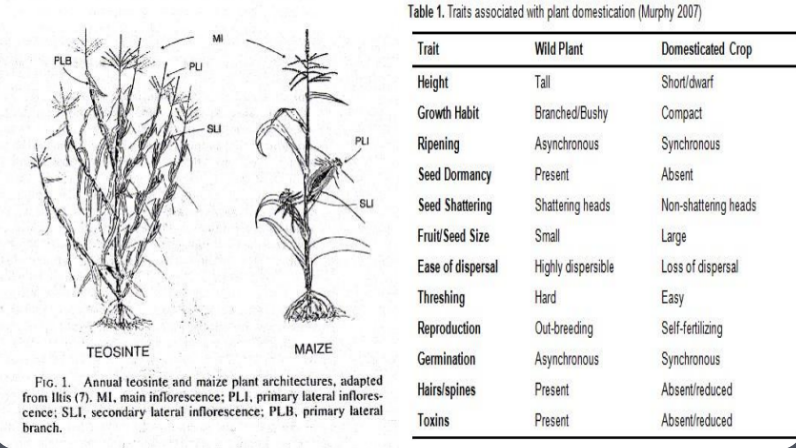
How does domestication affect natural selection?
Domestication modifies selective pressures on plants by favoring traits beneficial for human use over those that thrive in the wild, potentially reducing genetic diversity and fitness in natural environments.
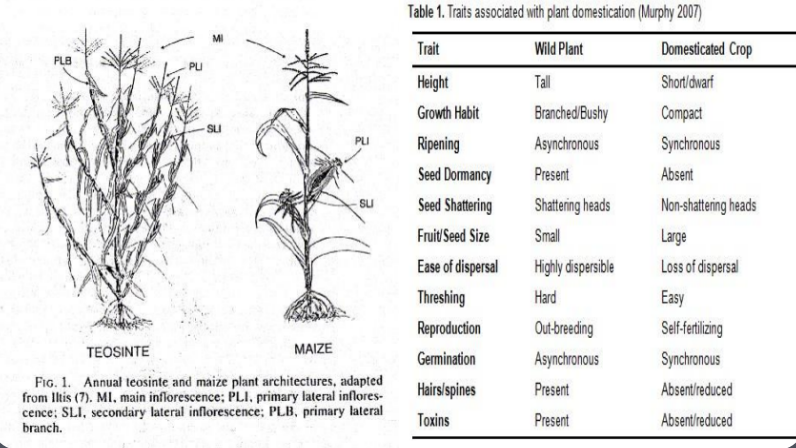
What is the domestication syndrome?
is the characteristic collection of phenotypic traits associated with the genetic change from a wild progenitor to a domesticated form. They are typically selected by humans to have a favorable trait they want
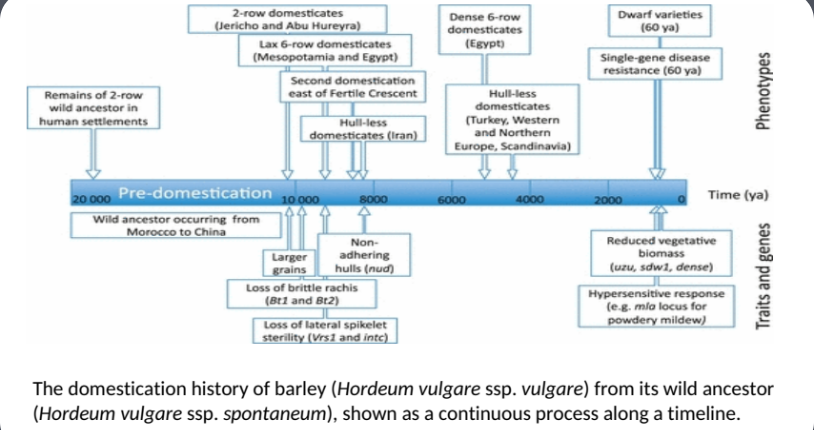
How do domesticated plants typically differ from their wild progenitors?
have larger fruits or grains, seed retention (nonshattering), more determinate growth, robust growth, loss of natural seed dispersal, some loss of communication with pollinators, loss of seed dormancy, decreased toxicity, changes in photoperiod sensitivity, and synchronized flowering.
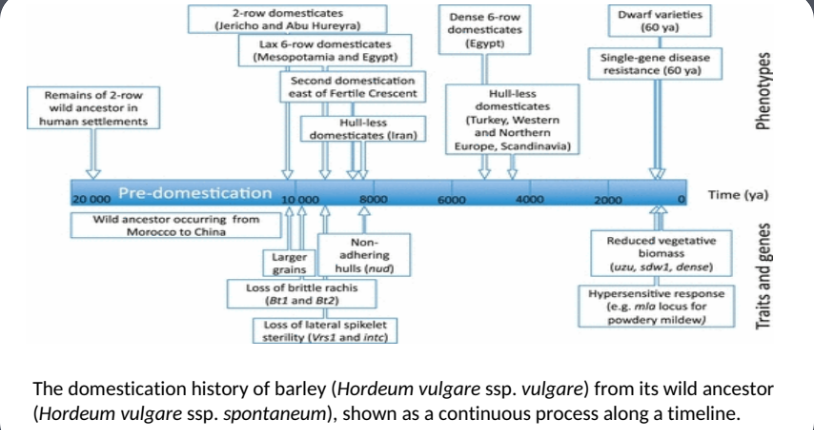
For which type of plants are domestication syndromes best characterized?
Domestication syndromes are best characterized for grasses.
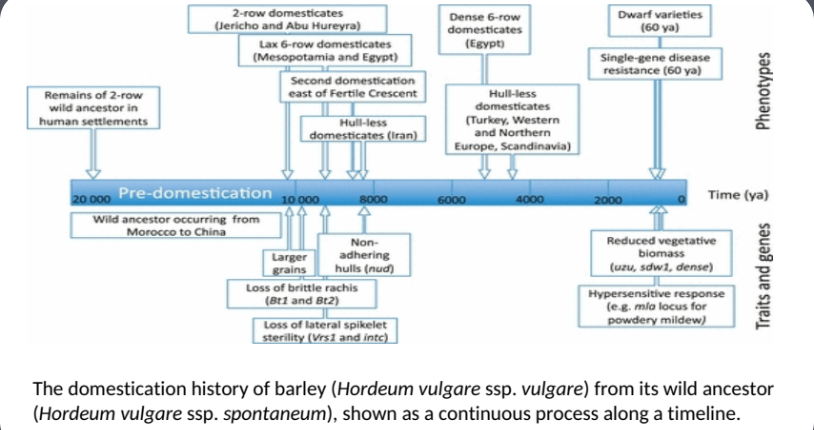
Do all traits arise simultaneously during domestication?
No
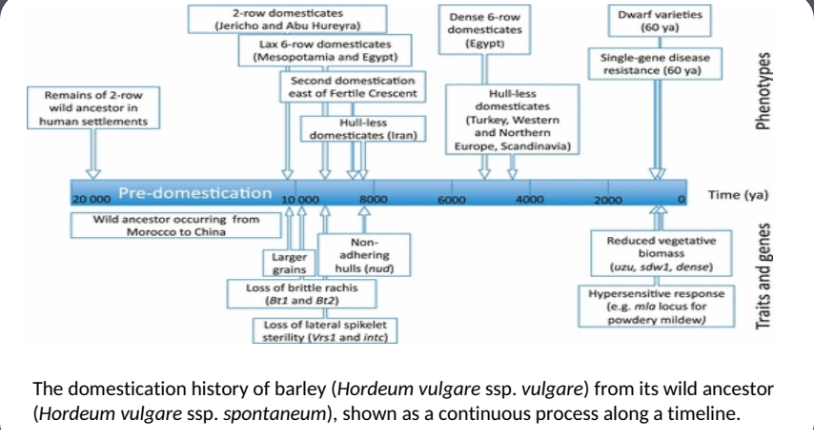
What trend has been observed regarding the speed of domestication?
There has been a general trend for domestication to occur much more rapidly in recent times.

Can similar domestication traits arise independently?
Yes, similar domestication traits may arise independently multiple times, often controlled by different genes.
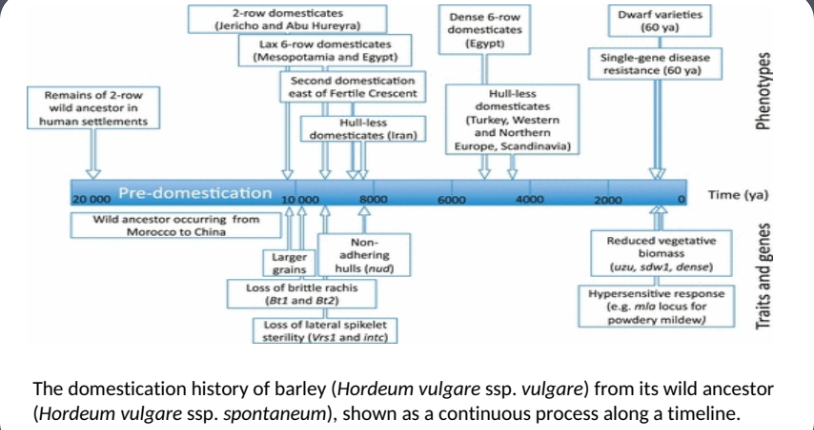
What is an example of a shared domestication trait?
The loss of a shattering mechanism of seed dispersal via a brittle rachis has arisen in many crops, particularly grasses

What dual selection processes do crop species experience?
Crop species experience both directed artificial selection and unintentional natural selection influenced by cultivation conditions.
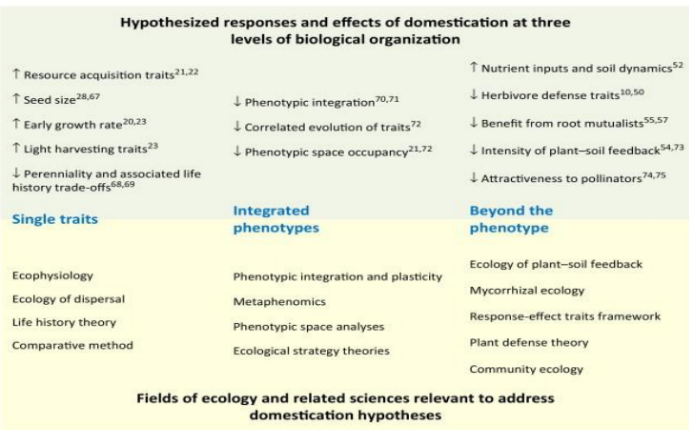
What additional genetic processes affect crop species?
Crops also experience genetic drift, inbreeding, random genetic mutations, and occasional crosses with closely-related wild species.
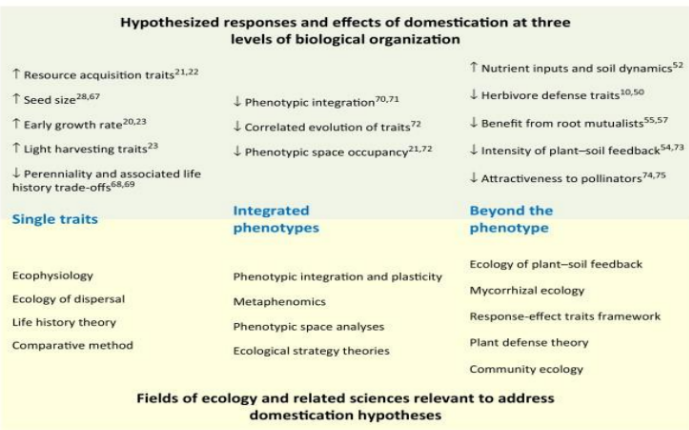
How have humans changed ecological processes in agricultural environments?
Humans have altered virtually every ecological process in habitats of early domesticates, which intensified with agricultural technology.

What are some specific changes humans have made to the agricultural environment?
Specific changes include supplying nutrients and water, high-density planting, reducing mutualistic relationships, protecting crops from herbivory and competition, regularly harvesting, and disturbing the soil.
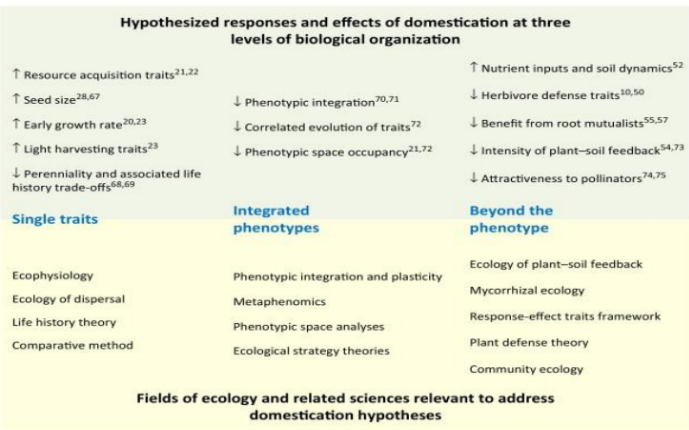
How does domestication affect plant fitness in natural environments?
Domestication typically selects against traits that increase fitness in natural environments, often leading to reduced fitness or an inability to survive outside cultivation.
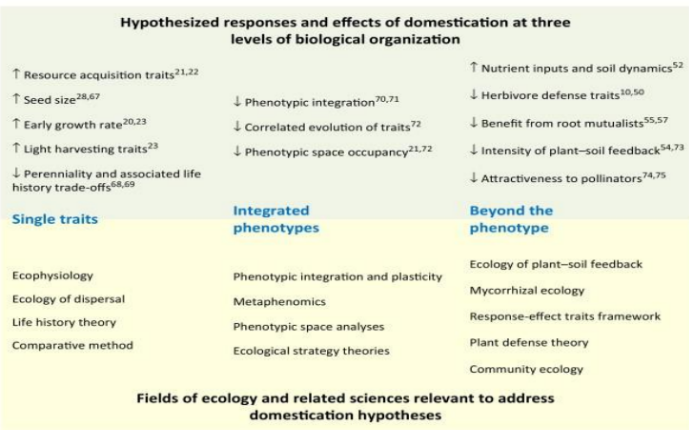
What is an example of a trait that limits a domesticated plant's ability to survive in the wild?
The nonshattering seed head of Zea maize prevents it from growing as a 'volunteer' outside agriculture.
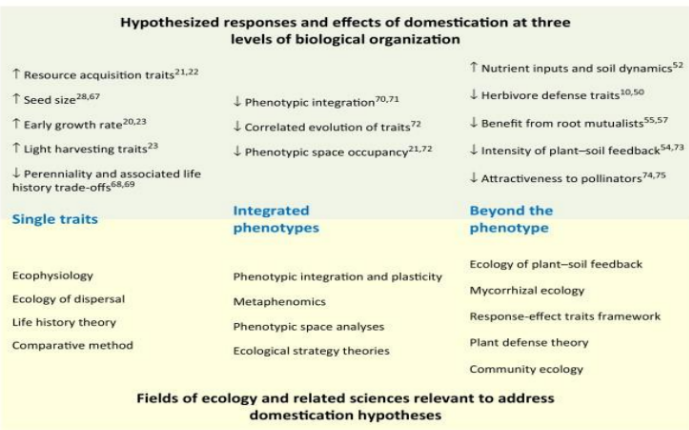
How do the effects of domestication extend beyond intended selections?
The effects extend beyond intention, creating selective pressures that modify domesticated plants in ways not originally intended by humans.
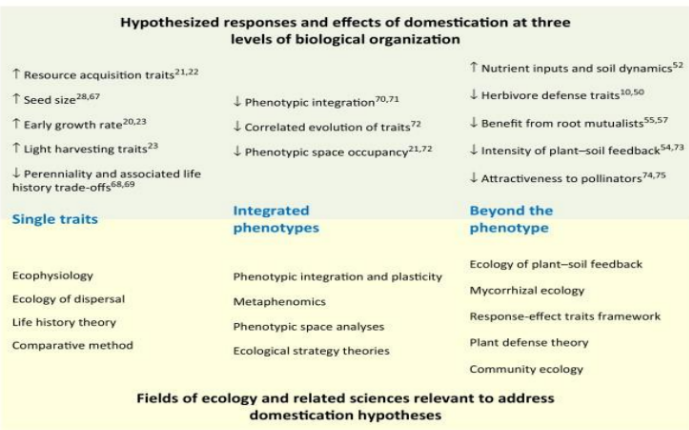
What traits do domesticated plants often lose due to altered environments?
They often lose traits that attract specific pollinators, defensive compounds against herbivores, and features useful for nonhuman seed dispersal
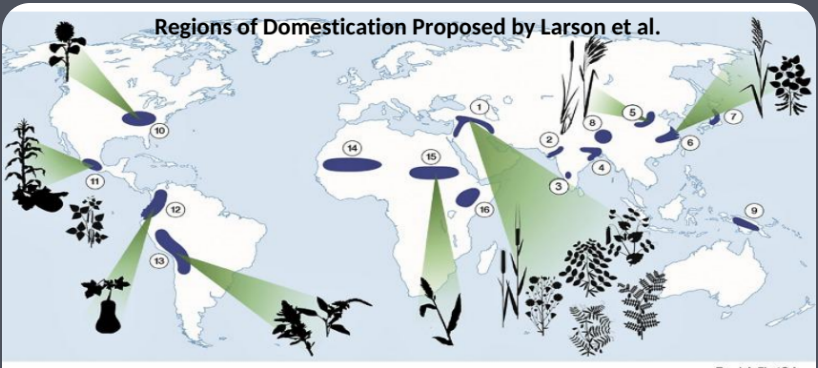
What role did early human gatherers have in plant selection?
Human gatherers exerted some selective pressure on plants they harvested, but these pressures were likely small and temporary until humans settled.
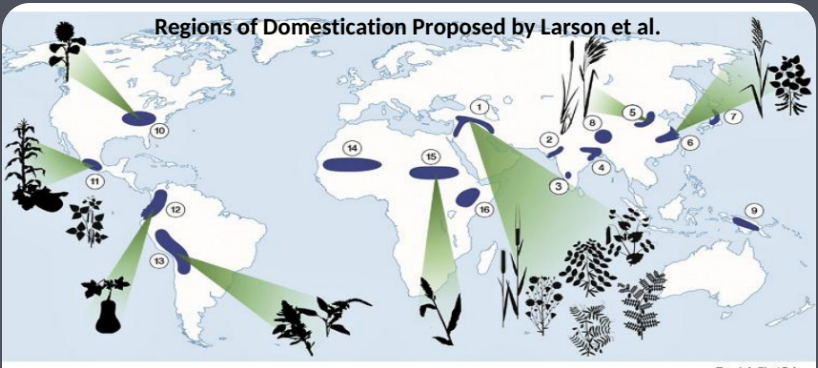
How did settled human populations impact plant selection?
Settled populations exerted strong, consistent selective pressures on certain plants they frequently interacted with, leading to mutualisms consistent with domestication.

What is the 'Neolithic revolution'?
The Neolithic revolution refers to the transition from hunter-gatherer societies to settled agriculture, occurring independently in various regions over 10,000 to 4,000 years ago.
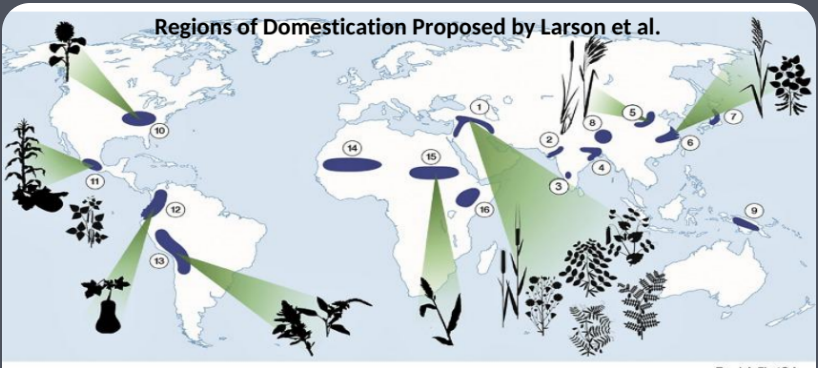
What factors have been theorized to explain the origins of agriculture?
Theories include changes in climate, population expansion, cultural practices, and religious beliefs.
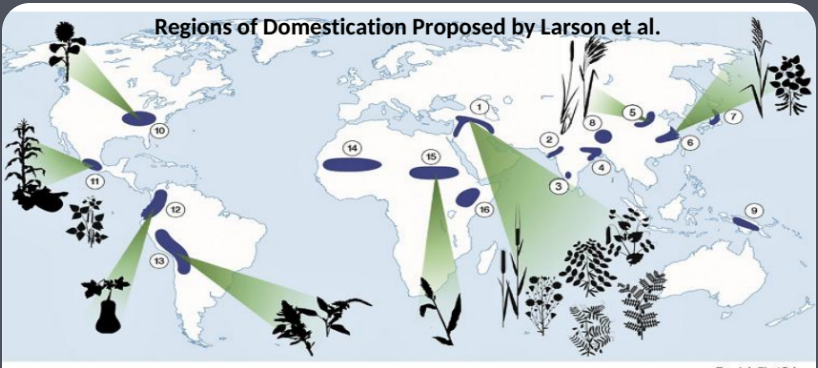
Was the origin of agriculture a singular event?
No, it occurred in different regions, such as Mesopotamia, with diverse motivations.
What does 'single origin' mean in the context of crop domestication?
A crop species has a 'single origin' when it was domesticated once from a wild ancestor.
What are 'multiple origins' in crop domestication?
'Multiple origins' occur when a crop is domesticated independently from the same ancestor in different locations or times.
Can multiple crop species originate from the same wild ancestor?
Yes, multiple crop species can be domesticated from the same wild species, such as broccoli, cauliflower, and brussel sprouts all originating from the same ancestor
What types of plants are suitable for domestication?
Only certain plants lend themselves to domestication based on their ecological adaptability.
Why might some desirable species not be domesticated?
Some species are too embedded in their own community ecology to be grown in a new context, often due to reliance on specific pollinators or microbial interactions.
Are long-lived species good candidates for domestication?
No, long-lived species are typically not easy targets for domestication.
What historical factors might influence the domestication of certain plants?
Some plants may be passed over for domestication due to historical reasons or their past use.
What is an example of a historically significant plant that was domesticated later?
Apios americana, or the ground nut, was a food for indigenous peoples in North America for centuries. It is considered a zone of unsustainability because it was not widely cultivated until recent times, despite its nutritional value and adaptability.
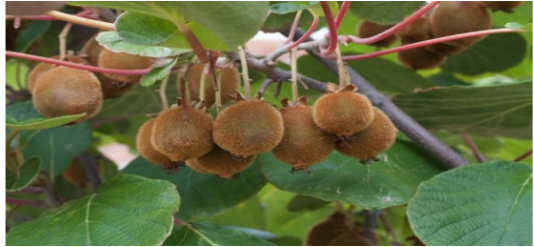
What is the botanical classification of the Kiwi fruit?
The Kiwi fruit is actually a gooseberry, scientifically named Actinidia deliciosa.
What type of tree is the Brazil nut?
The Brazil nut is a South American tree in the family Lecythidaceae, known as Bertholletia excelsa.
What are some characteristics of the Brazil nut tree?
It is one of the largest and longest-lived trees in the Amazon Rainforest, reaching up to 50 m tall and living for 500 to 1,000 years.
How long does it take for a Brazil nut tree to produce fruit?
It takes over 20 years for a Brazil nut tree to produce fruits, and it only does so in an intact rainforest.
Why has the Brazil nut tree never been domesticated?
Despite producing excellent wood and valuable seeds, the Brazil nut tree has never been domesticated due to its long maturation time and reliance on intact forest ecosystems.
What is the status of the Brazil nut in terms of commercial product and conservation?
Brazil nuts are commercially wild-harvested, and the tree is listed as vulnerable by the IUCN.
What was the global production of Brazil nuts in 2017?
In 2017, global production of Brazil nuts was 84,000 tonnes, primarily derived from wild harvests in tropical forests.
Why can't Brazil nut trees produce fruit in disturbed forests?
Disturbed forests lack the large-bodied bees necessary for pollinating the tree's flowers, which include the genera Bombus, Centris, Epicharis, Eulaema, and Xylocopa.
Is Brazil nut production economically viable from plantations?
Brazil nuts have been harvested from plantations, but production is low and currently not economically viable.
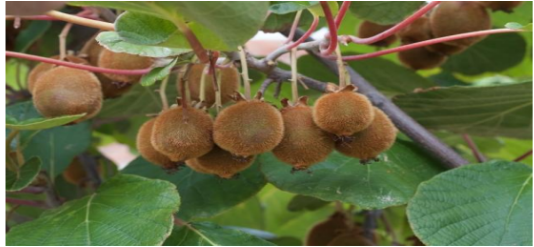
Why did the kiwi fruit became domesticated recently?
Kiwi fruit became domesticated relatively recently due to increasing demand for its unique flavor and nutritional value, leading to selective breeding for improved yield and resilience.
How recent is the domestication of the Kiwi fruit?
Almost every step in the domestication of the Kiwi fruit occurred within the last 100 years
What is the scientific name of the Pawpaw?
The scientific name of the Pawpaw is Asimina triloba.
Where is the Pawpaw native to?
The Pawpaw is native to the forests of the Eastern United States.
What type of plant family does the Pawpaw belong to?
The Pawpaw is a member of the Annonaceae family, which is mainly tropical.
What is unique about the Pawpaw in North America?
It produces the largest edible fruit native to North America.
How do Pawpaw fruits taste?
Pawpaw fruits have a sweet, custard-like flavor somewhat similar to banana.
What neurotoxin is found in the bark, leaves, and fruit of the Pawpaw?
The neurotoxin found in the Pawpaw is called annonacin.
Why has the Pawpaw never been successfully cultivated on a large scale?
It has never been successfully cultivated due to ecological factors.
In what types of environments do Pawpaws grow?
Pawpaws grow in floodplains and shady, rich bottomlands.
How do Pawpaws primarily spread?
Pawpaws primarily spread locally by root suckers, though sexual reproduction occurs at a low rate.
What type of pollination do Pawpaw flowers rely on?
Pawpaw flowers are insect-pollinated, but fruit production is limited by pollinators.
How do Pawpaw flowers attract pollinators?
They produce an odor similar to rotting meat to attract blowflies and carrion beetles.
What mammals eat Pawpaw fruits?
Mammals that eat Pawpaw fruits include raccoons, gray foxes, opossums, squirrels, and black bears.
Why are contemporary mammals not effective at dispersing Pawpaw seeds?
Contemporary mammals are not effective means of seed dispersal for Pawpaw seeds.
What historical animals were involved in the natural distribution of Pawpaw in North America?
Certain megafauna, including gomphotheres and mastodons, dispersed the Pawpaw before their extinction.
What is the primary cause of poor fruiting in cultivated pawpaw trees?
The most common cause of poor fruiting is lack of successful pollination.
What is a major challenge in managing pawpaw pollination?
Humans have not yet developed effective technology to manage flies as pollinators.
How long does it take for pawpaw trees to produce fruit?
Pawpaw trees take 7-8 years from seedling to fruiting.
What role does the pawpaw plant play in the ecosystem regarding butterflies?
Pawpaw is the larval host for the zebra swallowtail butterfly, but leaf damage does not affect the trees' fitness.
What problem limits the mass-marketing of pawpaw fruits?
Pawpaw fruits ripen to fermentation quickly after being picked, limiting their marketability; only frozen fruit stores or ships well.
What is Annonacin, and why is it a concern with pawpaw consumption?
Annonacin is a compound found in soursop, linked to neurodegenerative disorders; while occasional consumption of pawpaw is likely harmless, high intake raises concerns.
What impact did the Quaternary extinction of megafauna have on pawpaw?
It likely removed the dispersal mechanism for pawpaw seeds, greatly impacting its ecology.
What are some Anthropocene impacts on pawpaw ecology?
1) Quaternary extinction impacting dispersal. 2) Deforestation affecting ecological relationships. 3) Increased deer density due to predator extirpation. 4) Recent human cultivation efforts.
How has the extirpation of grey wolves affected pawpaw saplings?
It has led to a high density of White Tailed deer, benefiting pawpaw saplings as they have resistance to deer grazing.
What is currently being done to promote pawpaw as a new crop?
Kentucky State University has a full-time pawpaw research program aimed at developing this tree as a